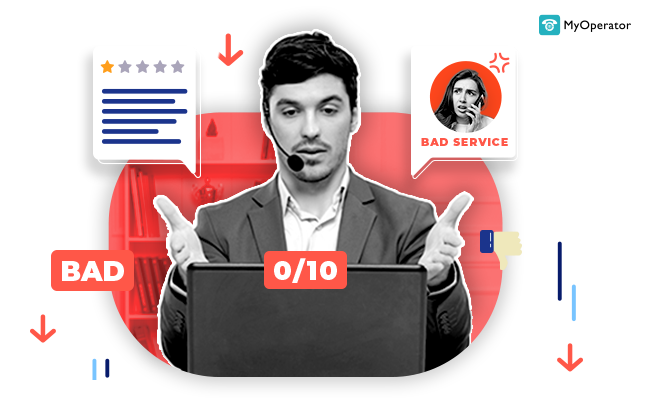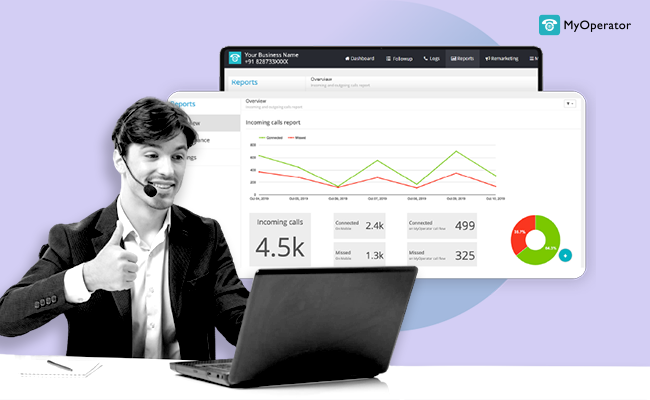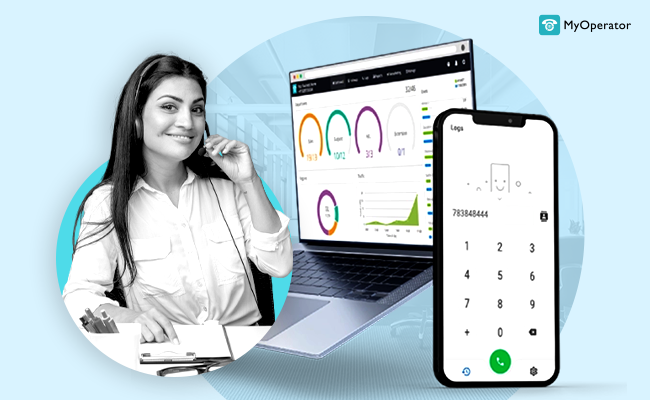In the fast-paced world of call centers, providing exceptional customer service is of paramount importance. It serves as the essential foundation for nurturing lasting customer satisfaction and facilitating continuous business growth. Leading this crucial task are call center executives who bear the responsibility of delivering outstanding customer experiences while shaping the brand’s reputation.
The establishment of a strong quality call center monitoring system is vital in this never-ending drive to not just meet but exceed customer expectations.
This comprehensive system encompasses various aspects such as call center quality monitoring, specialised software for quality monitoring, call center performance tracking, and an assortment of tools dedicated to assessing call center quality.

It plays a crucial function in both raising the overall call center quality monitoring scorecard and in identifying and fixing any flaws or errors in call center operations.
This quality monitoring system stands as the key component of contact center quality monitoring systems, providing an essential framework for achieving excellence in customer interactions and ensuring that call center mistakes are minimised.
What is Call Center Quality Monitoring?
Organisations use call center quality monitoring as an organised way to measure and improve the overall success and performance of call center customer interactions. Providing that customer care professionals continuously fulfill established requirements of communication and service delivery is the primary goal.
Such practice involves the regular assessment of various aspects, such as:
- Communication skills
- Adherence to scripts and protocols
- Resolution of customer issues
Organisations can assess and record data from customer interactions through various channels by using quality monitoring.
It includes a variety of communication channels in addition to phone calls, such as:
- Call records
- Email exchange with customers
- Connections on social media
- Evaluations of customer satisfaction
Call recordings are useful resources for assessing customer service personnel’s communication abilities, pinpointing areas in need of development, and guaranteeing compliance with corporate guidelines.
Conversations via email offer valuable insights into written communication, whilst interactions on social media provide an impression of customer attitude and involvement.
Customer satisfaction surveys also assist in determining areas that need development or attention, as well as in measuring overall satisfaction levels.
Why Call Center Quality Monitoring is important?
For a number of reasons, call center quality monitoring is essential since it is essential for guaranteeing that customer care agents and customers have the best possible experiences.
The practice’s importance arises from its capacity to methodically assess and improve multiple elements of customer service, which in turn improves customer happiness and loyalty.
Since it acts as a proactive tool to pinpoint areas where a company can improve, quality monitoring is crucial. Through close examination of customer interactions, companies can identify particular areas that might need focus, including:
- First call resolution rates
- Order processing efficiency
- Customer response times
These key performance indicators (KPIs) are essential for determining possible bottlenecks or inefficiency as well as to evaluate the call center’s overall effectiveness.
Additionally, quality monitoring helps companies to develop and put into practice procedures and policies that support providing customers with a reliable and superior experience.
Businesses can create focused initiatives to address gaps and improve the customer journey overall by identifying areas that need improvement.
Without further ado, here are some Call quality monitoring mistakes your call center must avoid:
1. Using Tickbox Reviews In Call Center Monitoring
Challenge: Monitoring call quality requires attention to detail.
Mistake: Relying on tickbox reviews prioritises checkboxes over the quality of service.
Solution: Highlight the shift to qualitative reviews, placing equal weight on the tone of the agents and the content of the screenplay.
For extensive call center monitoring, make use of MyOperator’s advanced quality monitoring tools.
Use best practices for call center quality monitoring to guarantee outstanding performance.
Increase the importance of call quality monitoring while evaluating overall standards for customer service.

2. Inadequate Feedback Loops In Call Center Monitoring
Challenge: Effective communication within the cloud call center is essential.
Mistake: Team leaders lacking communication skills can hinder feedback delivery.
Solution: Encourage balanced and constructive feedback from team leaders to foster positive changes and enhance communication. MyOperator’s call center software aids in feedback management. Ensure that team leaders deliver criticism and feedback in a balanced way that keeps the team making positive changes.
- To achieve success in the call center, focus on effective communication.
- Use call center quality monitoring software to enhance communication assessment.
- Follow call center quality monitoring best practices for improved interactions.
- Implement call quality monitoring for better customer service.
- Choose quality monitoring software tailored for call centers to streamline processes.
3. Employee Well-being In Call Quality Monitoring
Challenge: Emotionally taxing calls can negatively impact call quality.
Mistake: Failing to provide breaks between difficult calls.
Solution: Encourage call center agents to take short breaks to reset emotionally, leading to improved customer service.
- Recognise that emotionally challenging calls exist.
- Understand the potential negative impact on call quality.
- Provide support and training for handling such calls effectively.
- Stress the value of emotional tolerance in cloud contact center representatives.
- Encourage supportive conditions at work that can help with emotional stress management.
- Observe and handle any indications of emotional exhaustion within the team.
4. Preventing negative burnout during customer service call monitoring
Challenge: Dealing with challenging calls can lead to employee burnout.
Mistake: Neglecting to address employee burnout.
Solution: Create a positive environment, articulate clear career progression, and provide incentives to combat burnout and boost customer service energy.
- Acknowledge the existence of challenging calls.
- Understand the connection between tough calls and employee burnout.
- Place strategies into effect to assist people at work who are handling challenging situations.
- Promote to take breaks and implement self-care routine to prevent burnout.
- Provide resources and training for stress management.
- Encourage a positive work environment to lessen the impact of challenging calls on the team’s well-being

5. Balanced Evaluation
Challenge: Quantitative measures can lead to complacency.
Mistake: Over Reliance on sliding scales for quality control.
Solution: Combine quantitative measures with personalised performance metrics to motivate agents to strive for excellence.
- Consider the impact of relying solely on numbers.
- Understand that quantitative measures may not capture the complete situation.
- Emphasise the importance of qualitative insights alongside quantitative data.
- Encourage a holistic approach to performance evaluation.
- For a well-rounded view, combine qualitative and quantitative metrics.
6. Continuous Training
Challenge: Training is crucial but often becomes outdated.
Mistake: Relying on static training materials.
Solution: Regularly update training materials, utilise interactive tools, and leverage mentorship from experienced call center staff to keep up with evolving customer expectations.
- Prioritise ongoing training for call center employees.
- Ensure training content stays current with industry trends.
- Integrate call center quality monitoring software into training programs.
- Incorporate call center quality monitoring best practices in training modules.
- Include call quality monitoring to enhance customer service skills.
- Regularly update training materials to align with the latest standards.
- Utilise quality monitoring software for call centers to assess training effectiveness.
- Keep customer service call monitoring as a key aspect of ongoing training.
7. Call Center Monitoring Without Focus at Work
Challenge: Distractions hinder call quality.
Mistake: Neglecting team members’ concentration.
Solution: Implement strategies such as partition walls to create a focused environment for improved customer care service.
- Implement call center quality monitoring software to identify distractions.
- To deal with obstacles, follow to best practices for call center quality monitoring.
- Promote the value of having a purposeful workspace.
- Provide training on minimising distractions during calls.
To reduce challenges, evaluate and modify workplace policies on a regular basis. - Incorporate call quality monitoring to ensure ongoing improvement.

8. Mindful Technology Adoption
Challenge: Balancing technology and personal interaction.
Mistake: Over-reliance on technology that depersonalised customer interactions.
Solution: Strike a balance between technology and personalised communication to maintain high call quality.
- Ensure that call quality monitoring supports personalised interactions.
- Encourage agents to use technology without compromising personal touch.
- Highlight how crucial it is to uphold strict call quality guidelines.
- Regularly review and adjust strategies to achieve the desired balance.
- Incorporate call quality monitoring to improve communication quality over time.
9. Personalised Evaluation In Call Quality Monitoring
Challenge: Scorecards offer a limited view of performance.
Mistake: Evaluating team members exclusively through scorecards.
Solution: Use scorecards as guidance for personalised feedback tailored to each team member’s strengths and weaknesses.
10. Customer-Centered Approach
Challenge: Quality monitoring must prioritise customer satisfaction.
Mistake: Complacency about low customer satisfaction rates.
Solution: Ensure that quality monitoring remains customer-centered and incorporates real-world customer feedback.
- Make an effort to understand and meet customer requirements.
- Enhance customer satisfaction by utilising feedback.
- Incorporate empathy and active listening in agent training.
- Implement call center quality monitoring tools to align with customer expectations.
- A customer-centric approach should be reflected in quality tracking processes.
The Role of Call Center Quality Monitoring Softwares
In a cloud call center setting, call center quality monitoring systems are indispensable in maintaining consistently high service standards. As customer expectations evolve, adaptability becomes key to providing top-notch service.
Ensuring dynamic team member training and performance tracking on an ongoing basis that responds to changing customer dynamics empowers your staff to deliver quality service on every call. Avoiding depersonalised feedback fosters a customer-centered approach that upholds call center goals.
To Sum Up
Delivering top-notch customer service in each interaction is crucial in the realm of call centers. MyOperator’s cloud call center solutions can aid in achieving this goal by adapting to ever-changing customer expectations and providing dynamic training options.
Ensure that team member training is dynamic and mindful of this setting so that they can provide quality calls every time.

Create a space where team members can genuinely focus on delivering outstanding customer service through individualised feedback. Thus, there will be no compromise on quality.
Some Key Takeaways:
- Overemphasis on metrics can lead to poor customer experiences.
- Neglecting feedback loops can hinder improvement efforts.
- Proactive, holistic quality monitoring is key to long-term success.







